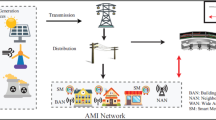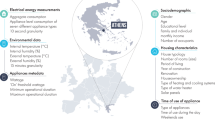Abstract
The smart grid is emerging as an efficient paradigm for electric power generation, transmission, and consumption, based on optimized decision making and control that leverage the measurement data of sensors and meters in the grid. False data injection is a new type of power grid attacks aiming to tamper such important data. For the security and robustness of the grid, it is critical to separate the false data injected by such attacks and recover the original measurement data. Nonetheless, the existing approaches often neglect the true changes on original measurement data that are caused by the real perturbations on grid states and hence have a risk of removing these true changes as injected false data during the data recovery. In this paper, we preserve these true changes by modeling the false data problem as a rank-bounded \(L_1\) norm optimization and propose both offline and online algorithms to filter out the injected false data and recover original measurement data. Trace-driven simulations verify the efficacy of our solution.








Similar content being viewed by others
References
Abur A, Exposito A G (2004) Power system state estimation: theory and implementation. Marcel Dekker Inc., New York
Bi S, Zhang YJ (2014) Graphical methods for defense against false-data injection attacks on power system state estimation. IEEE Trans Smart Grid 5(3):1216–1227
Bobba RB, Rogers KM, Wang Q, Khurana H, Nahrstedt K, Overbye, TJ(2010) Detecting false data injection attacks on dc state estimation. In: Preprints of the First Workshop on Secure Control Systems (SCS’10), CPSWEEK’10
Boyd S, Parikh N, Chu E, Peleato B, Eckstein J (2011) Distributed optimization and statistical learning via the alternating direction method of multipliers. Found Trends Mach Learn 3(1):1–122
Candès EJ, Li X, Ma Y, Wright J (2011) Robust principal component analysis? J ACM 58(3):11
Caro E, Conejo AJ, Minguez R (2009) Power system state estimation considering measurement dependencies. IEEE Trans Power Syst 24(4):1875–1885
Ganeshy A, Wright J, Li X, Candes EJ, Ma Y (2010) Dense error correction for low-rank matrices via principal component pursuit. In: Proceedings of the 2010 IEEE International Symposium on Information Theory (ISIT’10), pp. 1513–1517
Haldar JP, Hernando D (2009) Rank-constrained solutions to linear matrix equations using powerfactorization. IEEE Signal Process Lett 16(7):584–587
Kim TT, Poor HV (2011) Strategic protection against data injection attacks on power grids. IEEE Trans Smart Grid 2(2):326–333
Kosut O, Jia L, Thomas RJ, Tong L (2010) On malicious data attacks on power system state estimation. In: Proceedings of the 45th International Universities Power Engineering Conference (UPEC’10), pp. 1–6
Kushner HJ, Yin GG (2003) Stochastic approximation and recursive algorithms and applications, vol 35. Springer, Berlin
Liu Y, Ning P, Reiter MK (2010) False data injection attacks against state estimation in electric power grids. ACM Trans Inf Syst Secur 14(1):21–32
Liu L, Esmalifalak M, Ding Q, Emesih VE, Han Z (2014) Detecting false data injection attacks on power grid by sparse optimization. IEEE Trans Smart Grid 5(2):612–621
Morales JM, Baringo L, Conejo AJ, Mínguez R (2010) Probabilistic power flow with correlated wind sources. IET Gener Transm Distrib 4(5):641–651
Niesen U, Shah D, Wornell GW (2009) Adaptive alternating minimization algorithms. IEEE Trans Inf Theory 55(3):1423–1429
Shen Y, Wen Z, Zhang Y (2014) Augmented Lagrangian alternating direction method for matrix separation based on low-rank factorization. Optim Methods Softw 29(2):239–263
Siobhan G (2009) Electricity grid in U.S. penetrated by spies. http://online.wsj.com/articles/SB123914-805204099085
Wen Z, Yin W, Zhang Y (2012) Solving a low-rank factorization model for matrix completion by a nonlinear successive over-relaxation algorithm. Math Program Comput 4(4):333–361
Xu W, Wang M, Tang A (2011) On state estimation with bad data detection. In: Proceedings of the 50th IEEE Conference on Decision and Control and European Control Conference (CDC-ECC’11), pp. 5989–5994
Yang Q, Yang J, Yu W, An D, Zhang N, Zhao W (2014) On false data-injection attacks against power system state estimation: modeling and countermeasures. IEEE Trans Parallel Distrib Syst 25(3):717–729
Yuan X, Yang J (2009) Sparse and low rank matrix decomposition via alternating direction method. Pac J Optim 9(1):1–11
Acknowledgements
This work was supported in part by the National Natural Science Foundation of China (61502347, 61502504, and 61628209), the Nature Science Foundation of Hubei Province of China (2016CFB384 and 2016CFA030), the Fundamental Research Funds for the Central Universities (2042015kf0038), the Research Funds of Renmin University of China (15XNLF09), and the Research Funds for Introduced Talents of Wuhan University.
Author information
Authors and Affiliations
Corresponding author
Rights and permissions
About this article
Cite this article
Huang, H., Yan, Q., Zhao, Y. et al. False data separation for data security in smart grids. Knowl Inf Syst 52, 815–834 (2017). https://doi.org/10.1007/s10115-016-1019-8
Received:
Accepted:
Published:
Issue Date:
DOI: https://doi.org/10.1007/s10115-016-1019-8




